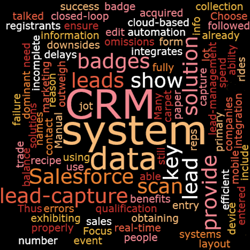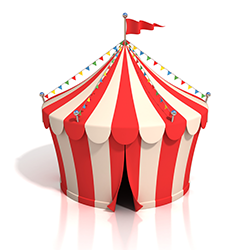|
REGISTRATION REQUIRED
exhibiting 101
 Rent Right
Allocate your exhibit-marketing budget wisely by knowing when to rent and when to buy. By Betsy Earle
In the trade show industry, there is always the question of renting versus purchasing an exhibit property and its ancillary elements, such as flooring, furnishings, and technology, e.g., flatscreen monitors, iPad kiosks, etc. Each option comes with financial and logistical pros and cons, including up-front costs, shipping and storage fees, and depreciation. While there is no magic formula for determining when it makes more sense to invest in ownership or enjoy the flexibility of renting, here are a number of scenarios and factors to consider during your decision-making process.
Exhibit Properties As little as 10 years ago, rental exhibits often looked the part, so to speak, in that they featured lackluster designs, few opportunities for customization, and no small amount of wear and tear. Today, however, rental properties have evolved to the point where they are practically indistinguishable from custom, owned exhibits, meaning you don't have to sacrifice professionalism by renting instead of buying. An industrywide rule of thumb is that buying an exhibit that you will use more than three times will save you money in the long run. That is because it will likely cost you more to rent a property three times than it would to buy it outright, so any subsequent uses are basically "free" in the context of the purchase price versus recurring rental fees. In addition to how often you'll use the exhibit, consider the following: ➤ Show locations — Where you exhibit most often may influence your decision to buy or rent. For example, what if the majority of your trade shows are close to your company headquarters on the East Coast, but you have one important expo in California? Depending on the size of your footprint and the related shipping costs, the most cost-effective solution may be to purchase the property you'll use for local shows and rent an exhibit for any long-distance events.➤ Booth size — Are all of your booths about the same size, or is there an outlier? For instance, one of my clients exhibits in a 20-by-20-foot space five times a year but has a 50-by-50-foot footprint at one show. After crunching the numbers, we decided to purchase a property to fit the smaller booth space and rent components to fill the larger footprint. It goes without saying that it makes little sense to have purchased assets collecting dust in a warehouse. ➤ Storage — Speaking of warehouses, the vast majority of exhibit houses will store your purchased exhibit and prep it for shipping – for a substantial fee that must be factored in to your budgeting process. To sidestep these recurring charges, some exhibitors store their properties at their own facilities. While I'm all for watching the bottom line, I implore my clients to consider the indirect costs associated with this strategy, chief among them the additional time and labor required. If you lack the manpower to inspect, prep, and pack your exhibit or the budget to outsource these efforts, renting may be your only feasible option. Flooring Renting exhibit flooring, whether it be carpet, vinyl, or laminate, from the general service contractor (GSC) comes with one important advantage: Your installation and material-handling fees will be included in the rental price, which simplifies your budgeting and eliminates the hassle of coordinating labor. However, rented flooring is often reused and might not be up to snuff when it comes to cleanliness and quality, and the range of available colors may be limited. If the aesthetics of your flooring must align with your overall exhibit and/or brand colors, you may need to fork over the cash for a custom treatment. When considering purchasing flooring, keep the total cost of ownership in mind, including shipping and drayage, installation, and, of course, cleaning. Some exhibitors take a "one and done" approach to flooring, i.e., they purchase new carpet for each show. While this negates cleaning and return-shipping fees, remember that you are still on the hook for paying the venue's disposal charges. Finally, if owning your own flooring makes the most sense for your program, consider all of your options before springing for a roll of carpet or vinyl, as some types of flooring are easier to reuse than others. I know of one exhibit manager who uses a system of interlocking tiles to form the floor of his 10-by-10. The tiles not only look stellar when laid out in his booth but also are a cinch to clean, can be installed by a single staffer, and pack into a modestly sized box. By "thinking outside the roll," this savvy exhibitor estimates that his flooring purchase saves him approximately $800 a year in labor, shipping, and rental fees.
If owning your own flooring makes the most sense for your program, consider all your options before springing for a roll of carpet or vinyl.
TechnologyIt seems like every time I step onto the show floor I see a new type of flatscreen monitor, LED video wall, or virtual- or augmented-reality system. Exhibitors' appetites for the latest and greatest technology are mind-boggling, as is the range of how they can apply it to their programs. So for the purposes of this column, I'll narrow my focus to the most common tech elements: monitors and tablets, both of which are readily found in even the most humble of 10-by-10s. As a general rule, I recommend that my clients rent their flatscreen monitors. This is due to the fact that such hardware 1) requires specialized shipping and handling, e.g., monitors must always be kept in an upright position, 2) is easily damaged, despite the availability of heavily padded shipping containers, and 3) is often rendered practically obsolete within a couple years of its purchase. Take, for example, a client who wanted to loop a presentation on a two-year-old monitor via a thumb drive. The display had barely lost its new-screen smell, but it already lacked the ability to loop any type of media file, forcing my client to hit the "Play" button every hour of the show. Just as the cost of renting flooring through the GSC includes installation and material handling, the fees associated with renting monitors through an official provider come with an added benefit: on-site tech support. When confronted with a dreaded "input error" message, what exhibitor wouldn't want a troubleshooting technician just a phone call away? Purchasing tablets, on the other hand, is a decision I can get behind. In addition to having countless uses and being remarkably easy to bring to the show floor, their ability to receive regular software updates means they'll be able to run cutting-edge programs long after their purchase date. And should a game-changing advancement occur, such as Apple debuting yet another proprietary charging port, chances are your last-generation device can still be of use somewhere at the company. Furnishings For small elements such as reception counters or product-display tables, one of the main considerations is whether you can use them in different booth configurations. If you know you are going to need these items at three or more shows, it's probably best to purchase, since these are versatile pieces that fit in most booth sizes. And by buying these items outright, you'll likely be able to incorporate custom countertops, logos, and other accents. If purchasing these elements would break the bank or if you need extra pieces for a larger exhibit once or twice a year, then consider renting basic models and dressing them up with your own fabric graphics, tablecloths, or vinyl decals. Exhibit furniture, e.g., chairs, sofas, coffee tables, etc., is ridiculously expensive regardless of whether you choose to rent or buy. Furniture rented through the GSC or another supplier will likely command sky-high rates, but this route is probably the better option once you factor in the shipping and material-handling fees associated with bringing purchased furnishings to the venue. If you have no choice but to purchase furniture – perhaps you need pieces to match a specific Pantone color – my one piece of advice is to assemble the elements before shipping to avoid having to pay your installation laborers to put them together on site. As you can see, determining if it makes more sense to rent or to buy is more than a matter of dollars and cents – it's also about dollars and sense. When deciding between renting or purchasing anything from an exhibit property to a tablet stand, check the numbers, naturally, but also ask yourself, "Does it make sense for me to own this part of my program?" In my experience, you'll be surprised how often you find yourself saying "No." And should you be on the fence, err on the side of caution and avoid the unique strain of buyer's remorse that comes from blowing your budget on a custom, corporate-hued sofa that ends up on Craigslist after your company undergoes a rebrand. E  Betsy Earle, CTSM
Betsy Earle, CTSMmanaging director and founder of Event Driven Solutions LLC. Earle obtained her MBA at the University of Miami and earned her Diamond-level CTSM designation in 2018. Exhibiting101@exhibitormagazine.com
|
|
|
||||||||||||||||||||||||||||
|
|
||||||||||||||||||||||||||||
|
TOPICS Measurement & Budgeting Planning & Execution Marketing & Promotion Events & Venues Personal & Career Exhibits & Experiences International Exhibiting Resources for Rookies Research & Resources |
MAGAZINE Subscribe Today! Renew Subscription Update Address Digital Downloads Newsletters Advertise |
FIND IT Exhibit Producers Products & Services All Companies Get Listed |
EXHIBITORLIVE Sessions Exhibit Hall Exhibit at the Show Registration |
ETRAK Sessions Certification F.A.Q. Registration |
EDUCATION WEEK Overview Sessions Hotel Registration |
CERTIFICATION The Program Steps to Certification Faculty and Staff Enroll in CTSM Submit Quiz Answers My CTSM |
AWARDS Exhibit Design Awards Portable/Modular Awards Corporate Event Awards Centers of Excellence |
NEWS Associations/Press Awards Company News International New Products People Shows & Events Venues & Destinations EXHIBITOR News |
||||||||||||||||||||
|
||||||||||||||||||||||||||||






